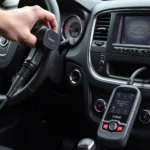The world of OBD2 (On-Board Diagnostics, second generation) can seem daunting at first glance, with its cryptic codes and technical jargon. Whether you’re a seasoned mechanic or a car enthusiast looking to delve into DIY diagnostics, understanding the language of OBD2 is crucial. This comprehensive guide breaks down common OBD2 terminology, empowering you to navigate the world of car diagnostics with confidence.
Unraveling the Basics: What is OBD2?
OBD2 is a standardized system implemented in vehicles manufactured after 1996 in the United States (and globally in most vehicles from 2001 onwards). It allows you to communicate with your car’s computer, retrieve diagnostic information, and understand the health of your vehicle’s various systems.
At the heart of OBD2 lies the Diagnostic Trouble Code, or DTC. These codes are the building blocks of understanding what’s going on under the hood.
 OBD2 port location
OBD2 port location
Decoding the Language of DTCs
A DTC is a five-character alphanumeric code that indicates a specific issue or malfunction detected by your car’s onboard computer. Let’s break down the anatomy of a DTC:
- First Character: Indicates the system where the fault lies. For example, “P” signifies a powertrain issue, “B” refers to the body, “C” denotes the chassis, and “U” points to networking problems.
- Second Character: Specifies whether the code is generic (applicable across car manufacturers) or manufacturer-specific. A “0” represents a generic code, while numbers “1” to “9” indicate manufacturer-specific codes.
- Third Character: Pinpoints the specific subsystem affected. For instance, “1” might refer to the fuel and air metering system, “2” could indicate the injector circuit, and so on.
- Fourth & Fifth Characters: These two digits represent the specific fault within that subsystem.
Understanding this structure empowers you to interpret DTCs more effectively. For instance, a code “P0171” tells you there’s a problem with the fuel system (“P”), it’s a generic code (“0”), related to the air and fuel metering system (“1”), and the specific fault is “71” (which often indicates a lean air-fuel mixture).
Beyond DTCs: Navigating Other Key Terms
While DTCs form the cornerstone of OBD2 communication, understanding a broader range of terminology will enhance your diagnostic capabilities:
- CAN (Controller Area Network): This is the communication network that allows various modules within your car to talk to each other.
- ECU (Engine Control Unit): Often referred to as the “brain” of your car, the ECU processes data from various sensors and controls engine functions.
- Freeze Frame Data: This snapshot captures engine parameters at the moment a fault code was stored, providing valuable context for diagnosis.
- Oxygen Sensor: This sensor monitors the oxygen content in the exhaust gases, helping optimize the air-fuel mixture for combustion.
- MAP Sensor (Manifold Absolute Pressure): This sensor measures the pressure inside the intake manifold, providing the ECU with crucial information about engine load.
Choosing the Right OBD2 Scanner: A Crucial Decision
To unlock the wealth of information available through OBD2, you need a reliable OBD2 scanner. These devices connect to your car’s OBD2 port and translate the raw data into understandable information.
There are various types of OBD2 scanners available, from basic code readers to professional-grade scan tools with advanced features. Understanding your needs and budget will guide you towards the right choice.
Torque Pro OBD2 & Car 1.8 80 APK is a popular option, offering a balance of functionality and affordability.
Common OBD2 Terminology: Frequently Asked Questions
Here are answers to some common questions about OBD2 terminology:
1. What is the difference between a pending code and a stored code?
A pending code indicates a potential issue that the ECU has detected but hasn’t confirmed yet. A stored code, on the other hand, means the fault has been confirmed and logged.
2. What does MIL stand for?
MIL stands for Malfunction Indicator Lamp, commonly known as the “check engine light.”
3. Can I clear my own OBD2 codes?
Yes, most OBD2 scanners allow you to clear codes. However, it’s important to address the underlying issue that triggered the code in the first place. Simply clearing the code won’t resolve the problem.
Empowering Car Owners: The Importance of OBD2 Knowledge
Understanding basic OBD2 terminology can be empowering. It allows you to:
- Diagnose car problems: Deciphering DTCs can give you a head start on understanding what’s wrong with your car.
- Communicate effectively with mechanics: Speaking the same language as your mechanic can save you time and money.
- Make informed decisions about repairs: OBD2 knowledge allows you to understand the scope of the problem and evaluate repair options.
Going Further: Resources for Continued Learning
This guide provides a foundational understanding of OBD2 terminology. For further exploration, consider these resources:
- OBDFree website: Top 5 OBD2 Scanners
- Manufacturer-specific resources: Refer to your car’s owner’s manual or the manufacturer’s website for information on specific codes and systems.
- Online forums and communities: Connect with other car enthusiasts and learn from their experiences.
“Understanding the language of OBD2 is like having a direct line to your car’s thoughts,” says John Smith, a veteran automotive engineer. “It allows you to move from guesswork to informed action when it comes to car maintenance and repairs.”
Conclusion: Mastering the Language of Your Car
OBD2 terminology may seem intimidating at first, but with a little effort, you can unlock its power. By understanding the basics of DTCs, key terms, and the role of OBD2 scanners, you can take control of your car’s health and navigate the world of automotive diagnostics with confidence.

